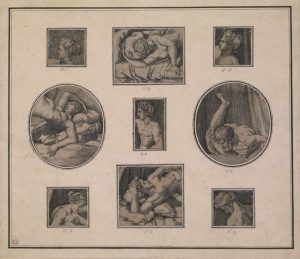You’re moving into a new home, so you hire the skilled artist who decorated your current house to decorate your new home. For whatever reason, you fall behind paying him. Explicit drawings of 16 positions for sexual intercourse are on your walls when you go to see his work.
That’s reportedly the situation Pope Clement VII found in the Vatican’s Apostolic Palace in 1524. But the Vatican drawings would end up in a bestselling pornographic book.
Several years before, Pope Julius II had hired Raphael, the master artist, to redecorate four rooms intended as papal apartments. The project outlasted both the Pope and Raphael. On Raphael’s death in 1520, the largest room remained unfinished. Giulio Romano, one of his assistants and heirs, worked on finishing the frescoes in the Sala di Constantino (“Hall of Constantine”) using Raphael’s sketches.
In 1518, Pope Clement, then a cardinal, hired Raphael to design and decorate a palace he was building outside Rome. Romano also became responsible for that project after Raphael’s death. Pope Clement, a Medici, was a chief advisor to the two popes who succeeded Pope Julius II before being elected to Pope himself in 1523.
As the Sala di Constantino neared completion in 1524, Romano became angry at Clement VII for late payment, according to art historian Lynne Lawner. As a result, he drew the 16 sexual positions on the room’s walls, she wrote in I Modi: The Sixteen Pleasures, An Erotic Album of the Italian Renaissance. Pope Clement did not sanction Romano, who finished Raphael’s frescoes and moved to Mantua, Italy. He would become the only specific Renaissance artist mentioned in a William Shakespeare play, described as “that rare Italian master Giulio Romano” in The Winter’s Tale.

Cropped collection of only surviving fragments of “I Modi”
By the early 1500s, books could be printed with illustrations. Sketches of Romano’s drawings ended up in the hands of Marcantonio Raimondi, who pioneered reproducing artwork in print and often collaborated with Raphael. Raimondi published Romano’s 16 sketches in 1524 as I Modi (“The Ways”), creating a Renaissance Kama Sutra. Pope Clement ordered all copies confiscated and destroyed, making it the first book of pornography banned by the Catholic Church. The Pope was so outraged he ordered Raimondi imprisoned for a year. Various appeals to the Pope, including his cousin, Cardinal Ippolito de Medici, and poet Pietro Aretino, led to the printer’s release after a few months.
That did not end I Modi’s story. Aretino wrote 16 Sonetti Lussuriosi (“Lust Sonnets”) to accompany the drawings, leading the Metropolitan Museum of Art to call him “the first modern pornographer.” In addition to explicitly describing the sexual acts, some of the sonnets’ characters were recognizable figures of the time. Raimondi and Aretino published this second edition of I Modi in 1527 and the book also became known as Aretino’s Postures and Sixteen Pleasures. “I know not which was the greater, the offense to the eye from the drawings of Giulio, or the outrage to the ear from the words of Aretino,” art historian Giorgio Vasari wrote in 1568.
Unsurprisingly, Pope Clement again banned the book. This time both printed copies and the original plates were destroyed. Only one complete image and some fragments survive, held by the British Museum. Aretino fled Rome for Venice. Raimondi evidently escaped punishment because he was taken for ransom by Spanish soldiers during the Sack of Rome in May 1527 and left Rome destitute.
Although the original was gone, counterfeit copies or attempted reconstructions continued to appear. One made with woodcuts was printed in Venice around 1550, perhaps because Aretino still lived there. In 1657, All Souls College at Oxford threatened several fellows with expulsion for trying to use the college’s printing press to reproduce the book. Despite, or perhaps because of, the church’s longstanding efforts to hunt down copies, a Renaissance bestseller was born. Romano’s 16 drawings have long disappeared; only Aretino’s sonnets remain.
Given how little of the first two editions of I Modi survived, a 1789 French book is the source of most later versions. Carraci’s Aretino combined Aretino’s sonnets with late 16th century engravings by Italian artist Agostino Carracci. Although purportedly based on Romano’s sketches, Carracci used figures from history and Greek and Roman mythology, making it easier to avoid censorship.
I Modi is an anachronism in today’s proliferation of digital porn. Yet, some may still find some amusement in the Vatican being the source of what is perhaps the first written pornography.
I know it when I see it.
Justice Potter Stewart, Jacobellis v. Ohio (1964)
(First posted at History of Yesterday)







